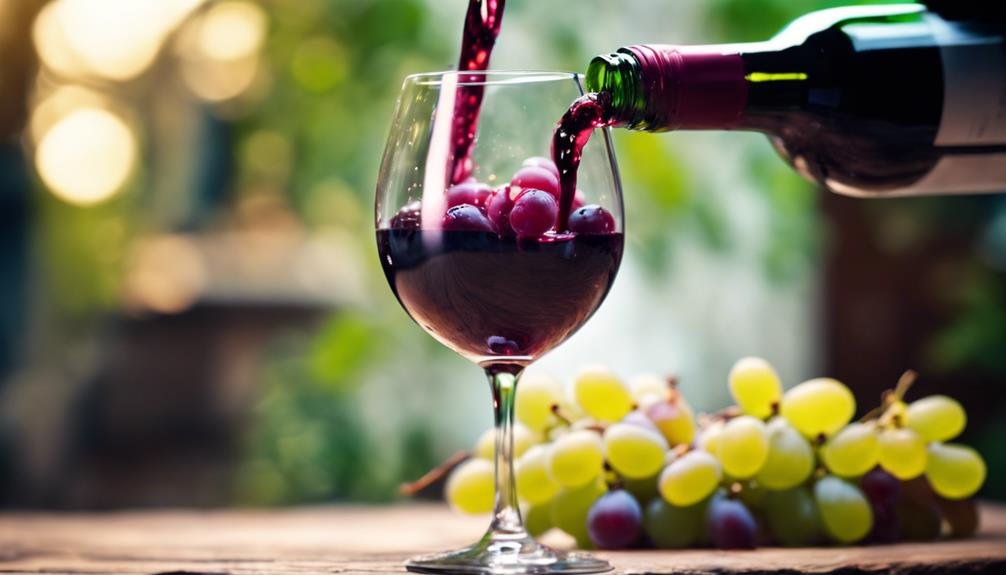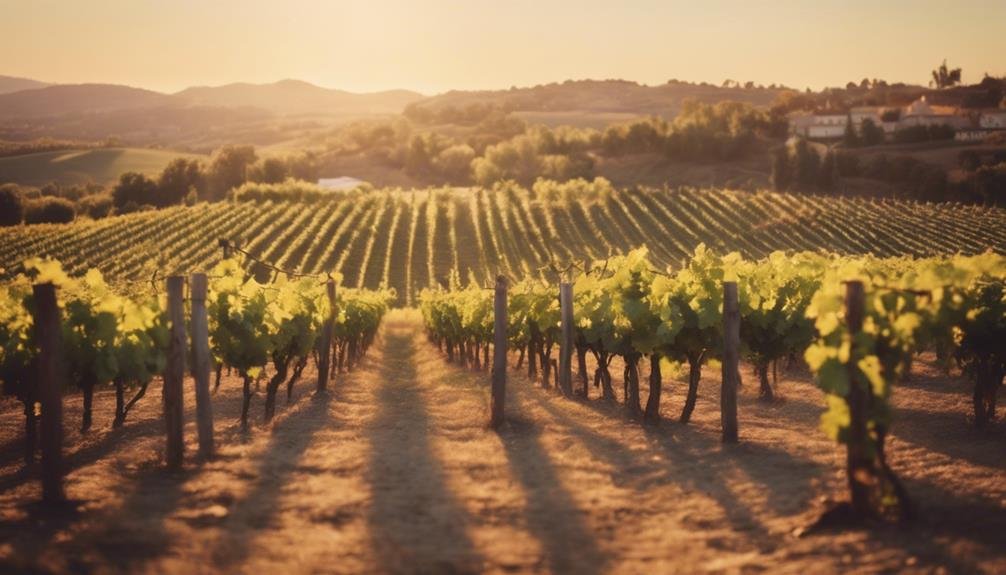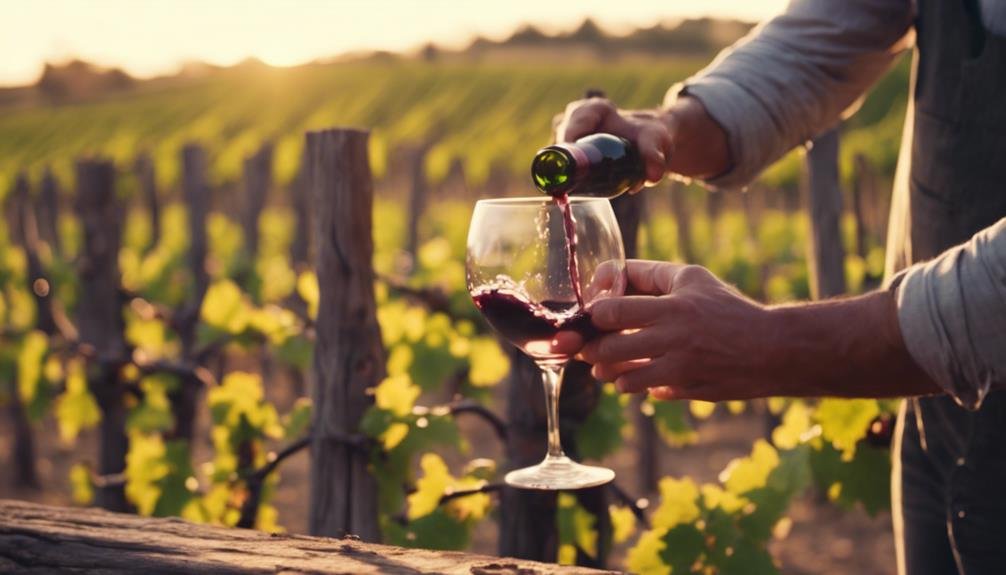Natural wines captivate with artisanal methods favoring minimal intervention and sustainable farming, yielding pure grape expression. Cloudy appearances and unique flavors reflect their unfiltered, indigenous yeast-induced nature. Health-wise, sulfite debates and biogenic amines concern some, while food pairing tips suggest seafood and varied temperatures for whites and reds. This sensory journey reveals earthy, vibrant flavors showcasing terroir and traditions. The allure lies in the surprises and delights awaiting enthusiasts who seek complex and distinct wine experiences.
Natural Wine Production Methods
Natural wine production methods encompass a range of artisanal techniques that prioritize minimal intervention and showcase the unique terroir of the vineyards. Sustainable farming practices in organic vineyards are fundamental, avoiding synthetic chemicals to promote biodiversity.
Indigenous yeasts, naturally present on grape skins, initiate fermentation, imparting distinct flavors. This hands-off approach allows for the pure expression of the grape and its environment. Fermentation techniques, such as carbonic maceration or extended skin contact, further enhance the complexity of natural wines.
Unique Characteristics of Natural Wines
Amidst the vast array of wine styles available, natural wines stand out for their distinctive and intriguing qualities that set them apart from conventionally produced wines.
One of the unique characteristics of natural wines is their cloudy appearance, which comes from being unfiltered. This unfiltered nature allows for a more genuine representation of the winemaking process, showcasing the wine in its purest form.
Additionally, the use of native yeasts in fermentation contributes to the distinct flavors and aromas found in natural wines. These yeasts influence the wine, creating a funkier, gamier, and yeastier profile that is less fruity compared to conventionally produced wines.
Health Considerations and Controversies

With the rise in popularity of natural wines, the discussion surrounding their health considerations and controversies has garnered significant attention in the wine industry.
The sulfites debate remains a focal point, with concerns about these additives causing headaches in some individuals. Additionally, the presence of biogenic amines in natural wines due to the use of native yeasts has raised implications for certain consumers.
While natural wines are often touted as additive-free and unmanipulated, their unfiltered nature may contain impurities that could affect sensitive individuals.
It is worth noting that sulfite-free wines, although appealing to some, may be more unstable in the long term, requiring careful storage and consumption practices to maintain their quality and integrity.
Tips for Enjoying Natural Wines
As the appreciation for natural wines grows, understanding how to maximize your enjoyment of these unique offerings can elevate your wine-drinking experience. When it comes to enjoying natural wines, paying attention to food pairings, tasting notes, serving temperatures, and glassware can enhance the flavors and aromas of these distinctive wines. Below is a table to guide you in savoring natural wines to the fullest:
| Tips for Enjoying Natural Wines | |
|---|---|
| Food Pairings | Tasting Notes |
| Opt for light dishes like seafood or salads | Note the funkier and yeastier characteristics |
| Avoid heavily spiced or creamy foods | Appreciate the less fruity, more yeasty aroma profile |
| Serving Temperatures | Glassware |
| Serve whites and rosés chilled at 45-55°F | Use a glass with a narrow bowl for whites and rosés |
| Light reds can be slightly chilled at 55-60°F | Opt for a glass with a wider bowl for reds |
Following these tips will help you fully experience the nuances of natural wines.
Exploring the World of Natural Wines

The world of natural wines offers a diverse array of unique and intriguing options for wine enthusiasts seeking distinctive and unadulterated flavors.
- Flavor profiles: Natural wines can showcase a range of flavors, from funky and earthy notes to vibrant and fruity undertones.
- Regional variations: Each wine region brings its own twist to natural winemaking, highlighting the terroir and traditions unique to that area.
- Food pairings: These wines can be versatile, pairing well with a variety of dishes, from seafood to charcuterie boards.
- Serving temperatures: Enjoy natural wines at slightly cooler temperatures to enhance their complex flavors and aromas.
Exploring the world of natural wines can lead to a sensory journey filled with surprises and delights.
Frequently Asked Questions
Are Natural Wines More Expensive Than Conventional Wines?
In comparing cost, natural wines often command higher prices due to small-scale production, sustainable practices, and hand-crafted quality. The quality debate centers on unique flavors and minimal intervention, appealing to those valuing authenticity and innovation.
Can Natural Wines Age as Well as Traditional Wines?
Natural wines can age well but exhibit different aging potential than traditional wines due to their unfiltered nature. Flavor profiles evolve uniquely, offering distinct tasting comparisons. Proper cellaring techniques can enhance their longevity.
Do Natural Wines Always Taste Funky and Yeasty?
While natural wines can exhibit funky flavors due to the unique fermentation process with native yeasts, not all taste yeasty. The diverse world of natural wines offers a spectrum of profiles, from earthy to fruity, appealing to varied palates.
Are All Natural Wines Considered Organic or Biodynamic?
Not all natural wines are considered organic or biodynamic. While many natural winemakers embrace organic or biodynamic practices, not all vineyards are certified. Natural wines prioritize minimal intervention in winemaking, focusing on sustainable and environmentally friendly methods.
Do Natural Wines Have a Higher Alcohol Content Than Regular Wines?
Natural wines often showcase higher alcohol content due to extended maceration periods during fermentation. This process allows for greater extraction from the grape skins. The unique viticulture practices and unadulterated nature contribute to distinct flavor profiles.
Conclusion
In the world of natural wines, each bottle is a canvas, painting a vivid picture of authenticity and craftsmanship.
As consumers continue to explore this unique domain of winemaking, they are treated to a sensory journey like no other, filled with flavors and textures that reflect the true essence of the vineyard.
Embracing the allure of natural wines offers a glimpse into the artistry and innovation that define this growing segment of the wine market.
